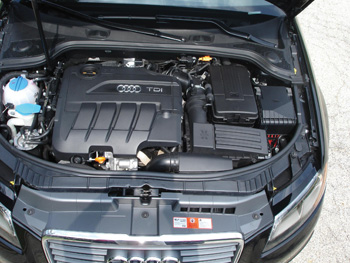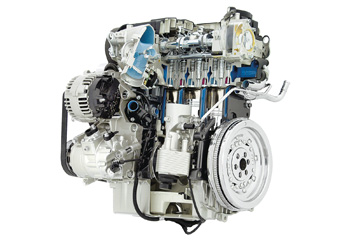Diesels have always been more fuel-efficient than gasoline engines thanks to their high compression ratios and ability to run very lean fuel mixtures. Diesel fuel also contains more heat energy per gallon than gasoline (about 138,700 BTUs versus 125,000 BTUs for gasoline), but the heavier hydrocarbons in the fuel tend to produce more HC and soot in the exhaust.
 Higher combustion temperatures in a diesel also produce more oxides of nitrogen (NOX). These factors combined with a traditional diesel engine’s noisy piston clatter, exhaust odor, hard cold starting characteristics and sluggish performance has limited their use in passenger cars — until recently.
Higher combustion temperatures in a diesel also produce more oxides of nitrogen (NOX). These factors combined with a traditional diesel engine’s noisy piston clatter, exhaust odor, hard cold starting characteristics and sluggish performance has limited their use in passenger cars — until recently.
A number of factors have combined in recent years to create a bright future for the latest generation of clean diesel cars and trucks. Common rail high-pressure direct injection systems with sophisticated electronic controls have transformed today’s diesels into clean-running, quiet and powerful powerplants more than capable of satisfying the most demanding drivers. Today’s diesel-powered import cars and SUVs drive and feel no different than their gasoline-powered counterparts while delivering 20 to 30 percent better fuel economy.
Another force that’s driving a move toward more diesels is new government regulations (which in the past have actually hindered diesel sales). The government wants all automakers (import and domestic) to significantly increase their Corporate Average Fuel Economy (CAFE) numbers over the next four years. In 2011, the average combined fuel economy for passenger cars and light trucks was 27.3 mpg, a number that has changed little over the previous decade. The actual breakdown was 30.2 mpg for cars and 24.1 mpg for trucks. The new regulations want automakers to achieve an average fuel economy of 39 mpg for cars by 2016, and 30 mpg for trucks, with a combined overall average of 35.5 mpg.
Domestic automakers have been using diesel engines in trucks for many years, but have not offered a diesel option in a passenger car since the 1980s. Even so, General Motors has announced that it will offer a diesel version of its popular Chevrolet Cruze in 2013. The engine will likely be a 2.0L turbodiesel capable of delivering 50 mpg on the highway. The Cadillac ATS will also get a diesel option in 2013.
Import vehicle manufacturers are currently taking two different approaches to meeting the new government fuel economy standards here. Many of the European automakers who sell diesel-powered cars in their home markets are offering diesels here (Audi, BMW, Mercedes and VW). They see a booming market for clean diesel technology in the U.S. Yet many Asian carmakers who sell diesels in Europe (Honda, Hyundai, Mazda, Mitsubishi, Nissan, Subaru and Toyota) currently do not offer any diesel-powered cars here. That stance may change in the years ahead, but for now the Asian carmakers are banking on hybrid vehicles and new direct injection gasoline engines to help them boost their fuel economy numbers. For example, Mazda’s new Skyactiv-G technology combines direct injection with ultra-high compression ratios (13:1) to boost fuel economy and performance up to 15 percent.
The hybrid market has shown steady growth in the U.S. in recent years, with more than a 100 hybrid models now available from both import and domestic auto makers. But the overall numbers are still relatively small, accounting for only about 2.5 percent of all new vehicle sales (and most of those have been Toyota Prius models). Hybrid production has been very limited due to the high cost of the technology (an extra $3,000 per vehicle on average) and limited battery production capacity here and abroad.
According to J.D. Power, approximately half a million hybrid vehicles were sold in the U.S. in 2011. By 2016, the sale of hybrid and plug-in electric vehicles is expected to grow threefold to an estimated 1.5 million vehicles per year.
By comparison, J.D. Power says the sale of new clean diesel cars and light trucks is expected to skyrocket in the U.S., going from 680,000 in 2011, to more than 900,000 by the end of this year (2012), to more than 9 million a year by 2016.
Current clean diesel vehicles include the Audi A3 and Q7 TDI models, BMW 335D and X5 xDrive35d, Mercedes E350, ML350, GL350 and R350 BlueTEC diesels, and VW Beetle, Golf, Jetta, Passat and Touareg TDI models.
CLEAN DIESEL ADVANCEMENTS
Compared to the diesel engines that were offered 20 years ago, today’s clean diesel engines produce 99 percent fewer oxides of nitrogen emissions, and 98 percent less particulate matter (soot) in the exhaust. That’s a huge difference. Fuel economy and performance are also much better. Some of today’s clean diesel cars are rated more than 40 mpg, such as the Audi A3 which gets 42 mpg on the highway with a 2.0L turbodiesel engine (50 percent better than the exact same car with a gasoline engine).
The technology that makes all of this possible is common rail fuel injection at very high pressures (up to 26,000 PSI) and frequencies. Clean diesels typically use piezo injectors that can cycle as many as five to eight times during an injection event. This allows very precise control over the combustion to reduce noise and improve efficiency.
 Though today’s clean diesel engines are engineered to run on ultra-low sulfur diesel fuel, most can also run on B5 (a 5 percent blend of biodiesel with diesel fuel). Research also is being done to determine the suitability of higher biodiesel blends, different types of biofuels including diesel-ethanol blends and the use of diesel-butanol blends (butanol is a different type of alcohol that can also be made from corn). Future diesel fuels may even include tiny nanoparticles of metals, oxides, carbides, nitrides or nanotubes to improve combustion efficiency and fuel economy even more.
Though today’s clean diesel engines are engineered to run on ultra-low sulfur diesel fuel, most can also run on B5 (a 5 percent blend of biodiesel with diesel fuel). Research also is being done to determine the suitability of higher biodiesel blends, different types of biofuels including diesel-ethanol blends and the use of diesel-butanol blends (butanol is a different type of alcohol that can also be made from corn). Future diesel fuels may even include tiny nanoparticles of metals, oxides, carbides, nitrides or nanotubes to improve combustion efficiency and fuel economy even more.
CLEAN DIESEL DRAWBACKS
One of the drawbacks of current clean diesel technology is the need for some type of exhaust after-treatment to clean up soot and other pollutants. Conventional “three-way” catalytic converters that work well with gasoline engines do not work as efficiently with the oxygen-rich combustion fumes that lean-burn engines produce. The catalyst usually requires more platinum (which is expensive) and other additives (an alkaline oxide such as barium oxide) to handle the pollutants. What’s more, a separate Diesel Particulate Trap (DPT) is usually required to catch soot.
Many diesels also add an after-treatment system (Selective Catalytic Reduction or SCR) that injects a water-urea solution (Diesel Exhaust Fluid or DEF) into the exhaust. On Mercedes BlueTEC diesels, the fluid is called “AdBlue.” At gas stations and truck stops, the fluid is usually marketed as DEF.
Diesel Exhaust Fluid is a solution of 67.5 percent purified water and 32.5 percent urea (ammonia). When this type of after-treatment system is used, it reduces the amount of Exhaust Gas Recirculation (EGR) that the engine needs to control NOX. This, in turn, allows the engine to be calibrated for slightly better overall fuel economy.
On vehicles that use a DEF after-treatment system, the fluid is stored in an onboard tank and is sprayed into the exhaust after the diesel particulate trap to break down oxides of nitrogen. The storage capacity will vary depending on the vehicle, and usage will depend on how the vehicle is driven. Typically, a gallon of fluid will last about 2,500 miles. The storage tank may hold enough fluid to go the distance of an oil change (7,500 miles up to 15,000 miles). EPA rules require the DEF level to be monitored, and that a warning light be used to signal the driver when the fluid level is low. Furthermore, the engine must power down to a limp-in mode if the after-treatment system runs out of DEF — which can create a real problem for the unwary driver who allows his fluid level to run out.
Another concern with DEF is that the liquid freezes at 12 degrees Fahrenheit (-11 degrees Celsius). This requires a tank heater to keep the reservoir warm during cold weather, and to thaw frozen fluid following a cold start if the fluid has turned to ice.
Next-generation after-treatment systems may eliminate the need for DEF and the periodic maintenance requirements to keep the fluid level filled. Automakers are developing and testing new diesel catalysts that use no platinum and do not require urea injection to control oxides of nitrogen. General Motors says it has a diesel converter that uses “perovskite oxide” (metal oxide) instead of platinum to treat diesel exhaust.
Mazda’s Sky-D technology for diesel engines also promises to eliminate the need for NOX aftertreatment. By lowering the compression ratio of a diesel engine, and injecting fuel into the combustion chamber earlier in the compression stroke, the engine can burn cooler and cleaner allowing it to meet current and future diesel emission standards. Variable lift exhaust valves are also used to retain more heat during the compression stroke and to aid cold engine starting.
The engine still requires a large oxidation catalyst and a particulate trap, but no DEF aftertreatment or other bandaids.
Mazda says its Sky-D technology boosts fuel efficiency 20 percent over current clean diesel engines. No word yet as to which models Mazda will put their new Sky-D 2.2L diesel in, but some say it may be offered in the 2013 CX-5 later this year.











